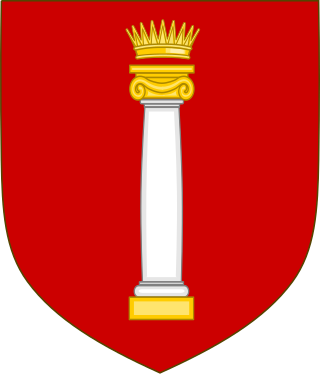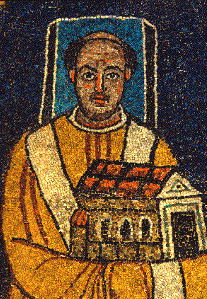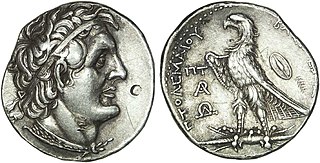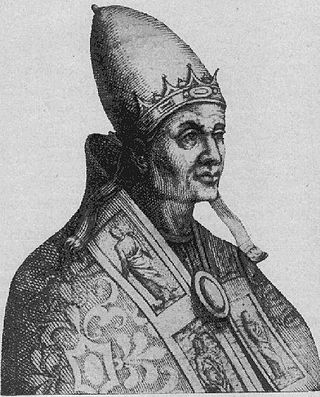
The House of Colonna, also known as Sciarrillo or Sciarra, is an Italian noble family, forming part of the papal nobility. It was powerful in medieval and Renaissance Rome, supplying one pope and many other church and political leaders. The family is notable for its bitter feud with the Orsini family over influence in Rome, until it was stopped by papal bull in 1511. In 1571, the heads of both families married nieces of Pope Sixtus V. Thereafter, historians recorded that "no peace had been concluded between the princes of Christendom, in which they had not been included by name".

Pope Paschal I was the bishop of Rome and ruler of the Papal States from 25 January 817 to his death in 824.

Pope Gelasius II, born Giovanni Caetani or Giovanni da Gaeta, was head of the Catholic Church and ruler of the Papal States from 24 January 1118 to his death in 1119. A monk of Monte Cassino and chancellor of Pope Paschal II, Caetani was unanimously elected to succeed him. In doing so, he also inherited the conflict with Emperor Henry V over investiture. Gelasius spent a good part of his brief papacy in exile.
Pope John XIII was the bishop of Rome and ruler of the Papal States from 1 October 965 to his death. His pontificate was caught up in the continuing conflict between the Holy Roman emperor, Otto I, and the Roman nobility. After long and arduous negotiations, he succeeded in arranging a Byzantine marriage for Otto II, in an effort to legitimize the Ottonian claim to imperial dignity. He also established church hierarchy in Poland and Bohemia.
Pope John X was the bishop of Rome and nominal ruler of the Papal States from March 914 to his death. A candidate of the counts of Tusculum, he attempted to unify Italy under the leadership of Berengar of Friuli, and was instrumental in the defeat of the Saracens at the Battle of Garigliano. He eventually fell out with Marozia, who had him deposed, imprisoned, and finally murdered. John’s pontificate occurred during the period known as the Saeculum obscurum.

Ptolemy is a male given name, derived from Ancient Greek and meaning 'warlike'. It is formed from the Epic Greek πτόλεμοςptolemos meaning 'war'. The name was used throughout the Greek world, but was particularly popular in ancient Macedon and its nobility. During the Hellenistic period, Ptolemy I Soter, a general of Alexander the Great, founded the Ptolemaic dynasty which ruled their Kingdom in Ancient Egypt. All male rulers of the dynasty bore the name 'Ptolemy', the last being Ptolemy XII Auletes, father of Cleopatra. Common variants include Ptolemaeus (Latin), Tolomeo (Italian) and Talmai (Hebrew).
Sylvester IV, born Maginulf, was a claimant to the Papacy from 1105 to 1111 in opposition to Paschal II. A priest before his election, he was probably a native of Rome. He had the backing of the Roman militia and initially of the Holy Roman Emperor, Henry IV, who later forced him to abdicate. Today he is regarded as an antipope.
Robert I, was count of Aversa and prince of Capua from 1106, on the death of his elder and heirless brother Richard. Robert was the second eldest son of Jordan I of Capua and Gaitelgrima, daughter of Guaimar IV of Salerno.

The counts of Tusculum, also known as the Theophylacti, were a family of secular noblemen from Latium that maintained a powerful position in Rome between the 10th and 12th centuries. Several popes and antipopes during the 11th century came from their ranks. They created and perfected the political formula of noble-papacy, wherein the pope was arranged to be elected only from the ranks of the Roman nobles. The Pornocracy, the period of influence by powerful female courtesans of the family, also influenced papal history.
Ptolemy was an Alexandrian mathematician, astronomer, geographer and astrologer.
Alberic I was the Lombard Duke of Spoleto from between 896 and 900 until 920, 922, or thereabouts. He was also Margrave of Camerino, and the son-in-law of Theophylact I, Count of Tusculum, the most powerful man in Rome.
Pier Leoni was the son of the Jewish convert Leo de Benedicto and founder of the great and important medieval Roman family of the Pierleoni. He was called the Jewish Crassus by Gregorovius.
The family of the Pierleoni, meaning "sons of Peter Leo", was a great Roman patrician clan of the Middle Ages, headquartered in a tower house in the quarter of Trastevere that was home to a larger number of Roman Jews. The heads of the family often bore the title consul Romanorum, or "Consul of the Romans," in the early days.
Richard II, called Richard of Aquila, was the consul and duke of Gaeta, ruling from 1104 or 1105 to his death.
Ptolemy II was the count of Tusculum and consul of the Romans from 1126 to his death. He was the son and successor of Ptolemy I.
Jonathan was the count of Tusculum from the death of his father, Ptolemy II, in 1153 to his own death. His mother was Bertha, illegitimate daughter of Henry V, Holy Roman Emperor.
Raino, also Rayno, Ranulf, or Reginulf, was the last count of Tusculum from an unknown date when he was first associated with his elder brother, Jonathan, to his own death. His father, Ptolemy II, died in 1153. His mother was Bertha, illegitimate daughter of Henry V, Holy Roman Emperor.

The Tusculan Papacy was a period of papal history from 1012 to 1048 where three successive relatives of the counts of Tusculum were installed as pope.

The 1118 Papal Election was held to choose the successor for Pope Paschal II, who died in Rome on 21 January 1118, after an 18-year pontificate. Pope Gelasius II was elected as his successor. The election happened during the Investiture Controversy, a conflict between supporters of the Papacy and those of the Holy Roman Emperor. The election was held under the threat of possible violence due to the controversy. The Cardinal electors took refuge in the Benedictine monastery, S. Maria in Pallara, during the election. Within minutes of his election as pope, Gelasius II was attacked and imprisoned by the Frangipani faction, supporters of the Holy Roman Emperor. Gelasius managed to escape, but at the emperor's arrival with his army, he fled Rome and never returned.

The 1086 papal election ended with the election of Desiderius, abbot of Monte Cassino as Pope Gregory VII's successor after a year-long period of sede vacante.